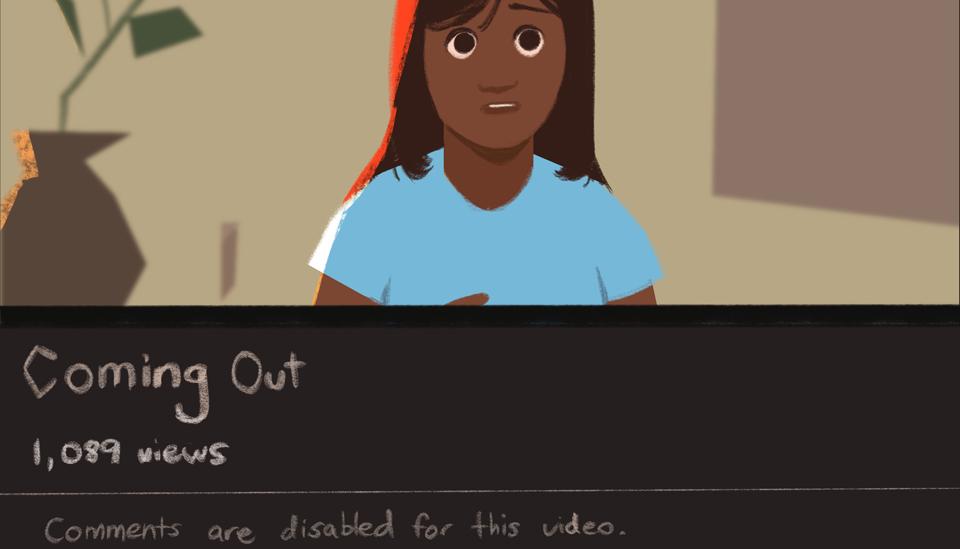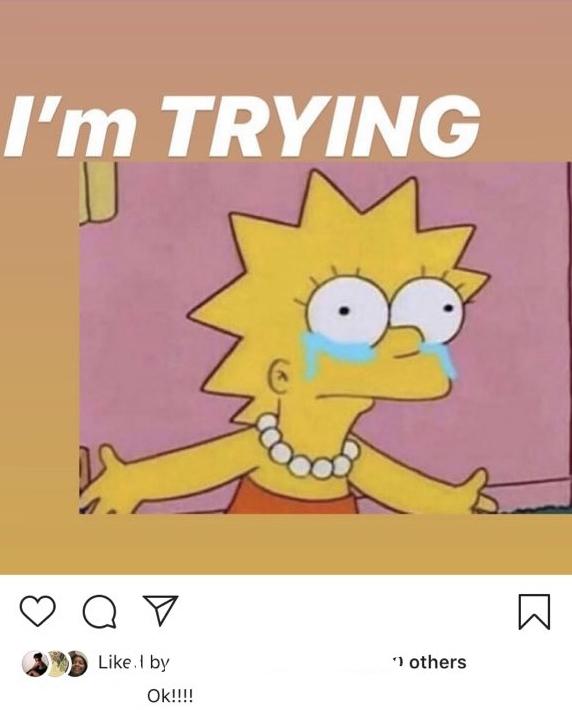
Image description: Illustration of person captioned coming out and comments disabled. Illustrator: Nabigal-Nayagam Haider Ali
The internet has long been a place where minorities and the marginalised could meet, find love and community, express and discover themselves and organize and mobilize in ways that would otherwise be difficult or impossible offline. As the internet continues to evolve and new social media platforms come up, queer people find ways to turn these often antagonistic spaces into their own. Instagram has been known to be extremely hostile towards women, sex workers, queer and trans people; going so far as to delete accounts, shadow-ban users and force them to take down posts the moderators and algorithms deem “inappropriate” as per the community standards”. This is a standard built on anti-blackness, queerphobia, misogyny, whorephobia and every other conceivable bigotry that targets the aforementioned groups.
Their message is loud and clear: you do not belong here. You do not belong to yourself. We will tell you who to be and what to do with your body.
You do not belong to yourself. We will tell you who to be and what to do with your body.
The Instagram content guidelines rolled out last year were skewed in favour of only allowing content that gratified and centred men. A notable example of this is women can no longer post topless pictures unless they show the woman breastfeeding or unless they showed mastectomy scars. In short, they only want to see women’s bodies if they can be interpreted to be in service of a “biological prerogative” or if they show the suffering of women. All of this sudden heavy-handedness about who gets to occupy space and express themselves over the internet is a clear reaction to feminist and queer rights movements and organising that has been happening online. This strong presence of women, queer people, people of colour and all groups that exist at the intersections of these identities has steadily grown over the past few years, and with them, the attempts to push them to the margins once again.
In the wake of this spike in censorship, many queer and trans people on Instagram have created anonymous, private accounts or Finstas, as they’re commonly known. This is not a new phenomenon, as finstas have been around and reported on as early as 2015. Naturally, most of the reportage on finstas was greatly condescending, and scarcely featured the stories of Black people, let alone queer black people from the global south, in spite of them being the most likely to make use of these alt-accounts. There are only so many places one can get to express themselves when you come from or live in societies that have integrated the violent, state-sanctioned queerphobia in mainstream culture left behind by colonial masters. Finstas can offer anonymity, safety and a chance to find community and to express one’s queerness. It puts the user at the forefront of controlling their content, their audience and who they follow.
I talked to 3 queer people from different countries and ethnicities across Africa on how they use their finstas. I asked them about the content they posted, their audience, the criteria and methods for sharing their account handles with other people, the role of their finstas in their social lives and the challenges that come with having a finsta. The conversations have been edited for clarity.
The who’s and why’s of finstas
M is a queer Zimbabwean woman. She created her finsta in May 2017 following the passing on of her father. Initially, her finsta was a place to vent about the emotional turmoil of losing a parent and not having the space to express this grief as she was regarded as “strong” by her family. The purpose of her finsta has changed since then, she says.
“Most of my 2017-2018 posts are long winded rants on wanting to die and being suicidal but now in 2019 it’s a lot more on my sexuality and being positive. I speak a lot on queer issues and how repression is so real in Zimbabwe and the ways in which I feel my sexuality is used as a commodity”
Her finsta has also helped her become more expressive and able to talk about the things that were bothering her with her friends. For a time, she had no followers on it and would go there to speak to herself. After a while, she allowed her close friends to follow, and they would use the finsta to check up on her and find out what she was feeling and try to help her if she needed support or assistance form her. In the beginning she was more lax about who she allowed to follow her, but she realized that not everyone she added to her finsta was invested enough in her wellbeing to deserve that kind of access.
“At first it had about 150 followers and then I realised a lot of people don’t care about my well-being so it’s now down to 60. I removed anyone that’s not actively in my life, or didn’t contribute to a portion of my growth. Now if I consider you a friend I’ll follow you first and then accept your request”
M’s finsta is also a place of community with other queer people. Through it, she’s been able to get to know many more queer people, who regularly interact with all the queer content she posts. It is also the first place that she came out publically.
“The first place I ever came out was on my finsta because I knew there was a bunch of people ready to support me and help me create one of the few safe places in our country where we’re not subject to queerphobia”
L created her finsta in September 2018. She is a pansexual woman from Kenya. She posts rants, selfies and thirst traps, as well as things to do with her mental health and her relationships. Her finsta is also a way for her to ask for advice from her followers, who she says are friends she can trust. She vets them to make sure they’re people who are aware of her queerness and are safe to be around. For her, the finsta is a place for self-expression and a place to let her hair down. She’s not too pleased that she has to hide this part of herself from the general public following on her main account though.
“…it sucks that my being not cis-het is something I have to hide from my main page in this age of employers looking through social media. [My queerness] could be the difference between me and getting a job or not. Or even me being safe or not.”
C.A has had their finsta for just about a year now: since May 2018. They’re a nonbinary Nigerian living in Maryland, USA. Their parents are terribly strict and when they’re at home, they have to hide certain parts of themselves. They use their finsta to vent about things that make them sad, feedback from opportunities they’d applied to, posting pictures of themselves, the girl they’re talking to or pictures queer couples from the internet that they adore. Their followers are people close to them who they feel comfortable talking about their journey to figuring their queerness out. Most of their followers are queer as well.
“ I can talk about how I think I'm lesbian, and all of the confusion that comes with Queerness and labels. It's nice being able to explore this with other people. Even if they don't comment on it, they're kind of here to witness it and I can talk about it with them if I want.”

Methods of posting
Instagram has both the stories and timeline features and more often than not, a finsta user will put different content on these two posting mediums. For some of the respondents, there was no thought process behind what goes where; it was all random. For others, they selected the format very deliberately based on the kind of content they were going to post, and who was going to see it
M posts things to do with her mental health and her sexuality on her timeline, and uses the close friends feature of Instagram stories when she wants to reach out to her close friends and get advice from whichever of them is open to helping her out at the time. Sometimes she worries that some of the things she posts are too personal.
“Sometimes I’ll post something and I’m like, this is too personal for certain people to see and I’ll delete it, but I try to be as genuine as possible. I believe being a loud version of myself helps other people feel more comfortable. Keeping secrets has never done me any good and I try not to. If I see it’s something even one of my followers will resonate with I’ll probably post it”
L uses the stories feature to post things she doesn’t want to be permanent on her finsta, like rants, asking for advice and the occasional thirst trap. On her timeline, she posts selfies, photos with her friends and short videos of herself or her friends. All her timeline content includes all the personal things she cannot otherwise post on her main account.
“I do not like to post about my mental wellbeing or lack thereof on my main. Also things concerning my relationships be it romantic, platonic, familial or otherwise”
C.A posts random videos of themself onto their stories and uses the timeline posts when they need to vent.
Safety concerns
There’s always the risk of one’s finsta being discovered no matter how careful the user is. This risk is increased exponentially by the suggestions-algorithm that alerts other users to new accounts or suggests accounts that the people they follow are following. Linking one’s contacts with Instagram also compromises anonymity. Sometimes, having the wrong people becoming aware of your secret account can be detrimental or even downright dangerous for the user depending on who becomes aware of it. One may also be unfortunate enough to have untrustworthy people on their finsta who will compromise the safety of that space by screenshotting or otherwise sharing content with people not vetted by the user. Most of the time one can simply delete these unwanted follow requests, but others may confront finsta users in public and demand for access to them.
M reports having had some pretty terrible experiences with breach of trust and people’s entitlement to be allowed on her finsta. Some of the cis-het men following her that she had thought were her friends began to treat her differently and sometimes violently after she came out in an attempt to “fix her”. They would be outwardly disgusted by her being publicly intimate with other women and confront her about her posts on her finsta.
“On multiple occasions I’ve had boys bring up my finsta posts on sexuality and how I identify as pansexual/queer and be aggressive towards me. No one has ever physically laid a hand on me but I’ve been extremely uncomfortable and scared for my safety or my partners”
L’s experience has been better. She simply deletes unwanted requests and tells people she doesn’t want to follow her who ask about her finsta that she isn’t comfortable with having them there.
“I’ve become comfortable with telling people I don’t feel comfortable with them following my finsta. Because unfortunately the algorithm can screw you over. So now it’s just a lot of ‘no thank you’s’ and deleting requests”
C.A also deletes requests and hasn’t had any major incidents when people they wanted to keep their finsta from got to know about it. However, they did have a confrontation with a close friend they needed space from who found out about their finsta by mistake.
“I knew I had to address it but I kept procrastinating. Finally, I think she asked and I just explained that I needed space. It seems like we're good. We still talk often. I considered adding her but I still think the space is necessary.”
Conclusion
Finstas are an important space for the wellbeing of many queer African people. They fill the gap of public self-expression and community in very significant ways. They are a powerful way to reclaim a website that at its core is anti-black, anti-queer and anti-woman, and a testament to the ingenuity and resilience of young, queer black Africans.
- 4759 views






Add new comment